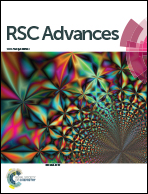Correlations between fluorescence emission and base stacks of nucleic acid G-quadruplexes†
Abstract
The aromatic 5/6 ring overlaps at the interface of 5′-5′ stacked dimers formed by two parallel G-quadruplexes have been demonstrated to produce a characteristic 385 nm florescence emission band excited at 260 nm. To further investigate the effect of base stacks within nucleic acid G-quadruplexes on the generation of the particular fluorescence emission bands, a series of G-rich DNA sequences are selected. They have been previously studied by NMR forming G-quadruplexes in which bases have defined glycosidic bond angles (GBA) and stack patterns; therefore, the G-quadruplexes give characteristic circular dichroism spectra termed as parallel or antiparallel structure. Herein, we measure their fluorescence emissions excited at 260 nm. Our results show that parallel G-quadruplexes can produce characteristic fluorescence emissions particularly when they stack at the interface in 5′-5′ manner regardless of aromatic 5/6 ring overlaps. Stacked guanines inside the G-quadruplex cores that present in anti GBA can also have a subtle influence on fluorescence emissions, which result in tailing peaks over 390 nm. Furthermore, the simultaneous presence of two remarkable emission bands around 330 nm and 385 nm is found to be related to the overall anti guanines stacking. These findings show potential use for providing topological information of G-quadruplexes based on characteristic fluorescence emissions.


 Please wait while we load your content...
Please wait while we load your content...